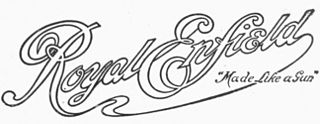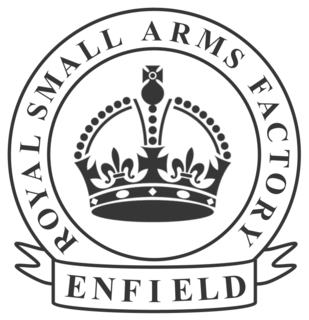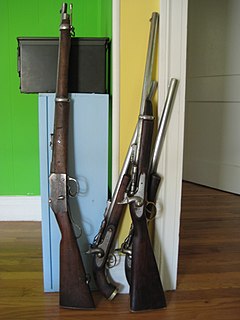
The Birmingham Small Arms Company Limited (BSA) was a major British industrial combine, a group of businesses manufacturing military and sporting firearms; bicycles; motorcycles; cars; buses and bodies; steel; iron castings; hand, power, and machine tools; coal cleaning and handling plants; sintered metals; and hard chrome process.

Bolt action is a type of manual firearm action that is operated by directly manipulating the bolt via a bolt handle, which is most commonly placed on the right-hand side of the weapon.

The Lee–Enfield is a bolt-action, magazine-fed repeating rifle that served as the main firearm of the military forces of the British Empire and Commonwealth during the first half of the 20th century, and was the British Army's standard rifle from its official adoption in 1895 until 1957. The WWI versions are often referred to as the "SMLE", which is short for the common "Short, Magazine, Lee–Enfield" variant.
The Rifle No. 5 Mk I, was a derivative of the British Lee–Enfield No. 4 Mk I, Following experience of jungle fighting in the Pacific War, the British came to "the conclusion that a rifle shorter and lighter than the standard issue, bolt action .303 cal No. 4 rifle was required." However its operational use was in post-war colonial campaigns such as the Malayan emergency, where it gained its common nickname of the "Jungle Carbine."

The Martini–Henry is a breech-loading single-shot rifle with a lever action that was used by the British Army. It first entered service in 1871, eventually replacing the Snider–Enfield, a muzzle-loader converted to the cartridge system. Martini–Henry variants were used throughout the British Empire for 47 years. It combined the dropping-block action first developed by Henry O. Peabody and improved by the Swiss designer Friedrich von Martini, combined with the polygonal rifling designed by Scotsman Alexander Henry.

Webley & Scott is an arms manufacturer founded in Birmingham, England. Webley produced handguns and long guns from 1834 to 1979, when the company ceased to manufacture firearms and instead turned its attention to producing air pistols and air rifles. In 2010 Webley & Scott restarted the production of shotguns for commercial sale.

Royal Enfield was a brand name under which The Enfield Cycle Company Limited of Redditch, Worcestershire sold motorcycles, bicycles, lawnmowers and stationary engines which they had manufactured. Enfield Cycle Company also used the brand name "Enfield" without the "Royal".

The Royal Small Arms Factory (RSAF) was a UK government-owned rifle factory in Enfield, adjoining the Lee Navigation in the Lea Valley. The factory produced British military rifles, muskets and swords from 1816. It closed in 1988, but some of its work was transferred to other sites.
The L42A1 is a bolt-action sniper rifle chambered for the 7.62×51mm NATO cartridge. Used in the past by the British Army, Royal Marines and Royal Air Force RAF Regiment, the L42A1 entered service in 1970. It was replaced by the Accuracy International AW in 1985.

The Gun Quarter is a district of the city of Birmingham, England, which was for many years a centre of the world's gun-manufacturing industry, specialising in the production of military firearms and sporting guns. It is an industrial area to the north of the city centre, bounded by Steelhouse Lane, Shadwell Street and Loveday Street.

Parker-Hale Ltd. was a British firearms, air rifle and firearms accessory manufacturer, located in the Gun Quarter of the city of Birmingham, England. It was founded by Alfred Gray Parker and Arthur Hale.
The Pattern 1913 Enfield (P'13) was an experimental rifle developed by the Royal Small Arms Factory for the British Army as a result of its combat experience in the Second Boer War from 1899 to 1902. The weapon was to serve as a replacement for the Short Magazine Lee–Enfield (SMLE). An advanced chamber design allowed for a high-velocity .276 Enfield rimless round, which was more powerful than the service-issued .303 British cartridge. Introduction of the P'13 was rendered impractical by the outbreak of the First World War.
The British .577 Snider–Enfield was a breech-loading rifle. The American Jacob Snider invented this firearm action, and the Snider–Enfield was one of the most widely used of the Snider varieties. The British Army adopted it in 1866 as a conversion system for its ubiquitous Pattern 1853 Enfield muzzle-loading rifles, and used it until 1874 when the Martini–Henry rifle began to supersede it. The British Indian Army used the Snider–Enfield until the end of the nineteenth century.

The origins of the modern British military rifle are within its predecessor the Brown Bess musket. While a musket was largely inaccurate over 100 yards (91 m), due to a lack of rifling and a generous tolerance to allow for muzzle-loading, it was cheaper to produce and could be loaded quickly. The use in volley or in mass firing by troops meant that rate of fire took precedence over accuracy.

Martini–Enfield rifles were, by and large, conversions of the Zulu War era .577/450 Martini–Henry, rechambering the rifle for use with the newly introduced .303 British cartridge. Whilst most Martini–Enfields were converted rifles, a number were newly manufactured as well.
Sporterising, sporterisation or sporterization is the practice of modifying military-type firearms either to make them suitable for civilian sporting use or to make them legal under the law.

A Khyber Pass copy is a firearm manufactured by cottage gunsmiths in the Khyber Pass region between Pakistan and Afghanistan.

The .303/25, sometimes known as the .25/303 is a wildcat centrefire rifle cartridge, based on the .303 British, necked down to fire a .257 projectile, originating in Australia in the 1940s as a cartridge for sporterised rifles, particularly on the Lee–Enfield action; similar versions also appeared in Canada around the same time.
Royal Ordnance plc was formed on 2 January 1985 as a public corporation, owning the majority of what until then were the remaining United Kingdom government-owned Royal Ordnance Factories which manufactured explosives, ammunition, small arms including the Lee–Enfield rifle, guns and military vehicles such as tanks. It owned some 16 factories; and employed about 19,000 staff.

A cadet rifle is a rifle used by military cadets and others for basic firearms and marksmanship training. Generally .22 caliber and bolt-action, they also come in semi-automatic versions. They are often miniature .22 caliber versions of standard issue service rifles.















